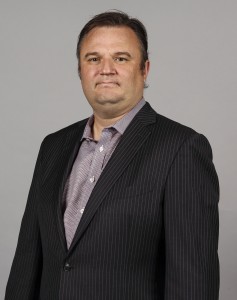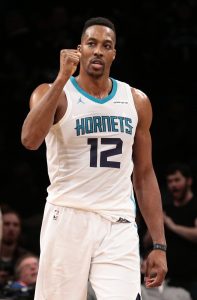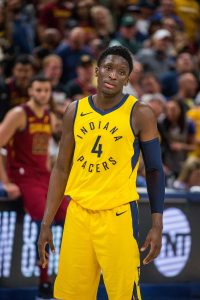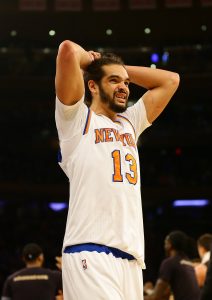While the NBA won’t announce this year’s award winners until late in June, we’re making our picks for the year’s major awards over the next two weeks.
The Hoops Rumors writing team has weighed in with our choices below, but we also want to know which players, coaches, and executives you think are most deserving of the hardware this season, so jump into the comments section below to share your thoughts.
We’re kicking things off today with the award for Executive of the Year. Here are our selections:
 Clark Crum: Kevin Pritchard (Pacers)
Clark Crum: Kevin Pritchard (Pacers)
Count me in as one of the many who believed the Thunder fleeced the Pacers last summer when they traded for Paul George and only got Victor Oladipo and Domantas Sabonis in return. George, 27, was a perennial All-Star and widely thought of as being one of the best two-way players in the NBA, while Oladipo, 25, had largely underperformed as a former No. 2 overall pick and Sabonis, 21, was still unproven.
Fast-forward 10 months later and Pritchard has made all of us doubters look like fools, as Oladipo was named an All-Star and largely outperformed George during the 2017/18 campaign, while Sabonis averaged 17.5 PPG in Indiana’s last four playoff games against the Cavaliers. Throw in the team-friendly offseason signings of starters Darren Collison and Bojan Bogdanovic – whose non-guaranteed contracts for next season combined total only $20.5MM – and the trade for sixth-man Cory Joseph while giving up essentially nothing in return, and you end up with a team that improved its win total by six games after trading away its franchise cornerstone.
Dana Gauruder: Dennis Lindsey (Jazz)
Losing your best player in free agency usually sets back a franchise for years. The Jazz should have been an also-ran when Gordon Hayward bolted. Instead, Lindsey solved their long-standing point guard issue and made them a playoff team. Trading up for Donovan Mitchell turned out to be a master stroke and Ricky Rubio bridged the gap to the Mitchell era.
Austin Kent: Kevin Pritchard (Pacers)
The 2017/18 Pacers were a breath of fresh air in a barely habitable runaway tankathon and that’s why Pritchard gets my pick for Executive of the Year. Rather than kowtow to the presumed fate of small-market teams destined to lose a franchise player, Pritchard wheeled Paul George to Oklahoma City for an intriguing young big man and an underwhelming former No. 2 pick. We didn’t know it then, but Pritchard had a meaningful plan to continue competing despite the setback. Rather than pass the buck and settle for the safe choice of an ambiguous future draft choice, Pritchard brought home tangible assets. The gamble on Victor Oladipo was a massive success — if he isn’t already as capable as George ever was in a Pacers jersey, he’s definitely more marketable. Domantas Sabonis, on the precipice of his 22nd birthday, looks every bit as promising as he did during his rookie season.
Pritchard didn’t settle there. Even if you chalk the George deal up to a pleasant surprise, the freshly-minted executive doubled down on the strategy to fill the team’s roster with capable adult basketball players. Crazy, right? The acquisition of Cory Joseph was shrewd and the signings of Bojan Bogdanovic and Darren Collison reinforce the notion that the man at the helm in Indianapolis has had a singular plan all along: while half the NBA zigs their way to uninspired combinations of current and former superstars and the other zags their way into the sub-20-win cellar, the Pacers barrelled down the middle.
Arthur Hill: Danny Ainge (Celtics)
Not only did he win the Gordon Hayward sweepstakes and get Kyrie Irving from the Cavaliers, Ainge pulled off a spectacular draft-related trade that looks better with each passing day. Instead of making the safe move by taking Markelle Fultz with the top pick, Ainge sent it to Philadelphia in exchange for the No. 3 choice, which brought Jayson Tatum, and a future first-rounder, which will probably be Sacramento’s in 2019. The Celtics could have been the No. 1 seed in the East if not for injuries to Hayward and Irving, and they still have the ammunition to trade for a star like Kawhi Leonard if he becomes available, giving Ainge a shot to win this award again next year.
Chris Crouse: Daryl Morey (Rockets)
This season’s Executive of the Year’s race was Morey’s to lose ever since he crafted the deal to bring Chris Paul to Houston. The Rockets headed into the 2017 offseason as an over-the-cap team, meaning they had to adhere to salary-matching rules in trades. The problem was that the Rockets had so much of their cap tied up in cap holds, rather than players under contract, that they couldn’t get to Paul’s $24.2MM figure without being creative.
Sam Hinkie‘s mentor scoured the NBA earth to add the pieces needed to complete the Paul deal. He looked under Western Conference rocks to find the likes of
DeAndre Liggins,
Tim Quarterman, and
Jarrod Uthoff, and navigated through the potential roster causalities of the Eastern Conference to bring in
Darrun Hilliard,
Shawn Long, and
Ryan Kelly. In the end, he was able to make the transaction, leading many to marvel at his shrewdness. Calling what Morey did creative probably doesn’t give him enough credit; he should probably be considered the Michael Jordan (or
LeBron James, depending on which way you lean) of NBA salary cap gymnastics.
Bringing in players is only part of an NBA GM’s job, as I mentioned when explaining my vote for Morey in last year’s
Hoops Rumors’ Awards. Franchises must be able to accurately gauge what they already have in house. For the second consecutive summer, Morey showcased a marvelous understanding of his team’s roster. He maintained his trust in
Clint Capela‘s development, which allowed the team to spend more resources on the perimeter. Adding Paul,
P.J. Tucker, and
Luc Mbah a Moute to an impressive core took the Rockets to new heights this season and Morey deserves recognition for his work.
Luke Adams: Danny Ainge (Celtics)
Ainge has taken plenty of criticism over the years for his apparent reluctance to roll the dice on potential blockbuster trades, but his 2017/18 moves vindicated that approach in spades. In signing Gordon Hayward, trading for Kyrie Irving, and flipping the No. 1 overall pick, Ainge swung for the fences to greater effect than than he ever did during his baseball days. The decision to hang onto young players like Jaylen Brown and Terry Rozier also paid off in a major way for Ainge and the Celtics, who saw those youngsters – along with Jayson Tatum – enjoy breakout seasons. Under-the-radar additions like Shane Larkin and Daniel Theis were just the icing on the cake.
Who is your pick for Executive of the Year? Share your choices and your thoughts in the comment section below!
Up next: Coach of the Year.
Photos courtesy of USA Today Sports Images.






 Clark Crum: Kevin Pritchard (Pacers)
Clark Crum: Kevin Pritchard (Pacers)